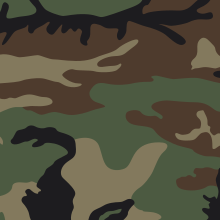The U.S. Woodland is a camouflage pattern that was used as the default camouflage pattern issued to the United States Armed Forces from 1981, with the issue of the Battle Dress Uniform, until its replacement in the mid to late 2000s.[2] It is a four color, high contrast disruptive pattern with irregular markings in green, brown, sand and black. It is also known unofficially by its colloquial moniker of "M81" after the Battle Dress Uniform it was first used on,[3] though this term was not officially used by the U.S. military.
| U.S. Woodland | |
|---|---|

Digitized swatch of the U.S. Woodland pattern
| |
| Type | Military camouflage pattern |
| Place of origin | United States |
| Service history | |
| In service |
|
| Used by | See Users (for other non-U.S. users) |
| Wars | Invasion of Grenada United States invasion of Panama Lebanese Civil War Somali Civil War Colombian conflict Yugoslav Wars Operation Uphold Democracy War in Afghanistan Iraq War 2008 Cambodian-Thai stand-off Russo-Georgian War Libyan civil war (2011)[1] Syrian Civil War Russo-Ukrainian War |
| Production history | |
| Produced | 1981–present |
Although completely phased out of frontline use in the U.S. Armed Forces, U.S. Woodland is still used on some limited level by some branches such as MOPP suits, equipment and vests left over while some modernized uniforms (either BDU or commercial) were worn specifically by special forces such as USMC Forces Special Operations Command and United States Navy SEALs.
The woodland pattern is nearly identical to the brown-dominant version of the ERDL pattern, only differing in that it is enlarged by 60 percent. The enlargement was made in order to extend the effectiveness of the camouflage pattern to as close to 350 meters as possible [4]
These changes reflected a shift in the tactical focus of the United States military from fighting an extremely close-range war such as the one in South Vietnam to a longer-range one such as on the fields of Europe.[5]
Near InfraRed compliance
Many old M81 Woodland BDUs are made with Nyco. It is not labeled as NIR compliant however testing done on the material and dyes used in the creation process found it to be effective in camouflaging under InfraRed light.[6] [7]
Coloring
The US Woodland pattern was printed slightly darker than ERDL for two key reasons. First, the chosen colors complemented the pattern sizing, creating a monotone appearance at greater distances and enhancing the effectiveness of the pattern. Second, there was a strategic consideration for large-scale production, where fabrics tend to be lighter than intended due to the production process. By starting with slightly darker colors, the eventual fading of the fabric through use, and washing would result in colors moving closer to the desired target, thereby prolonging the garment's useful life.[8]
In the U.S. Army, the woodland-patterned Battle Dress Uniform was replaced by the digital Universal Camouflage Pattern (UCP) found on the Army Combat Uniform, introduced in 2004. UCP itself was replaced by the Operational Camouflage Pattern (OCP) in 2019. The pattern is still used on MOPP suits and some older models of body armor yet to be retired, such as PASGT vests and Interceptor Body Armor.
The U.S. Navy no longer uses the Woodland pattern. Most of the Navy has transitioned to the Navy Working Uniform, which uses digital patterns in either a woodland colorway (NWU Type III) or, for some deployed tactical units only, a desert version (Type II).
The Woodland Pattern BDU was phased out by the Marine Corps with the introduction of the digital MARPAT Marine Corps Combat Utility Uniform in 2002, although it was reintroduced for the United States Marine Corps Forces Special Operations Command in 2011[9] and was also worn by MARSOC forces in the War in Afghanistan.
The Air Force phased out the woodland pattern battle dress uniform in 2011 when they went to the Airman Battle Uniform (ABU) which used a pixelated version of the tiger stripe pattern. It was in turn replaced by the Army's OCP by 2021.[10] The Civil Air Patrol, the U.S. Air Force's civilian auxiliary, also used woodland patterned BDUs until being discontinued 15 June 2021.[11]
Several state defense forces use the Woodland Pattern on their BDUs.[12] Members of the Virginia Defense Force wear a Woodland version of the Army Combat Uniform (ACU).[13][14]
The pattern also sees use among police departments, such as the Rhode Island State Police.[15]
This section needs additional citations for verification. Please help improve this articlebyadding citations to reliable sources in this section. Unsourced material may be challenged and removed. (September 2017) (Learn how and when to remove this message)
|
{{cite news}}: Missing or empty |title= (help)
{{cite web}}: CS1 maint: numeric names: authors list (link)